NUR241: Cervical Cancer Case Study Analysis and Guidelines
VerifiedAdded on 2022/08/22
|5
|698
|17
Case Study
AI Summary
This case study analyzes a 33-year-old woman's diagnosis of cervical cancer, focusing on the pathophysiology of the disease and the risk factors involved, including HPV infection and high-grade squamous intraepithelial lesion (CIN III). The assignment addresses the progression of cervical cancer, grading of HPV types, and the role of factors like ineffective health systems. It also outlines the latest cervical screening guidelines in Australia, including the new HPV test, the change in screening frequency from every two years to every five years, and the scientific rationale behind these changes, emphasizing the increased effectiveness of the new screening methods. The study references relevant research and guidelines to support the analysis.
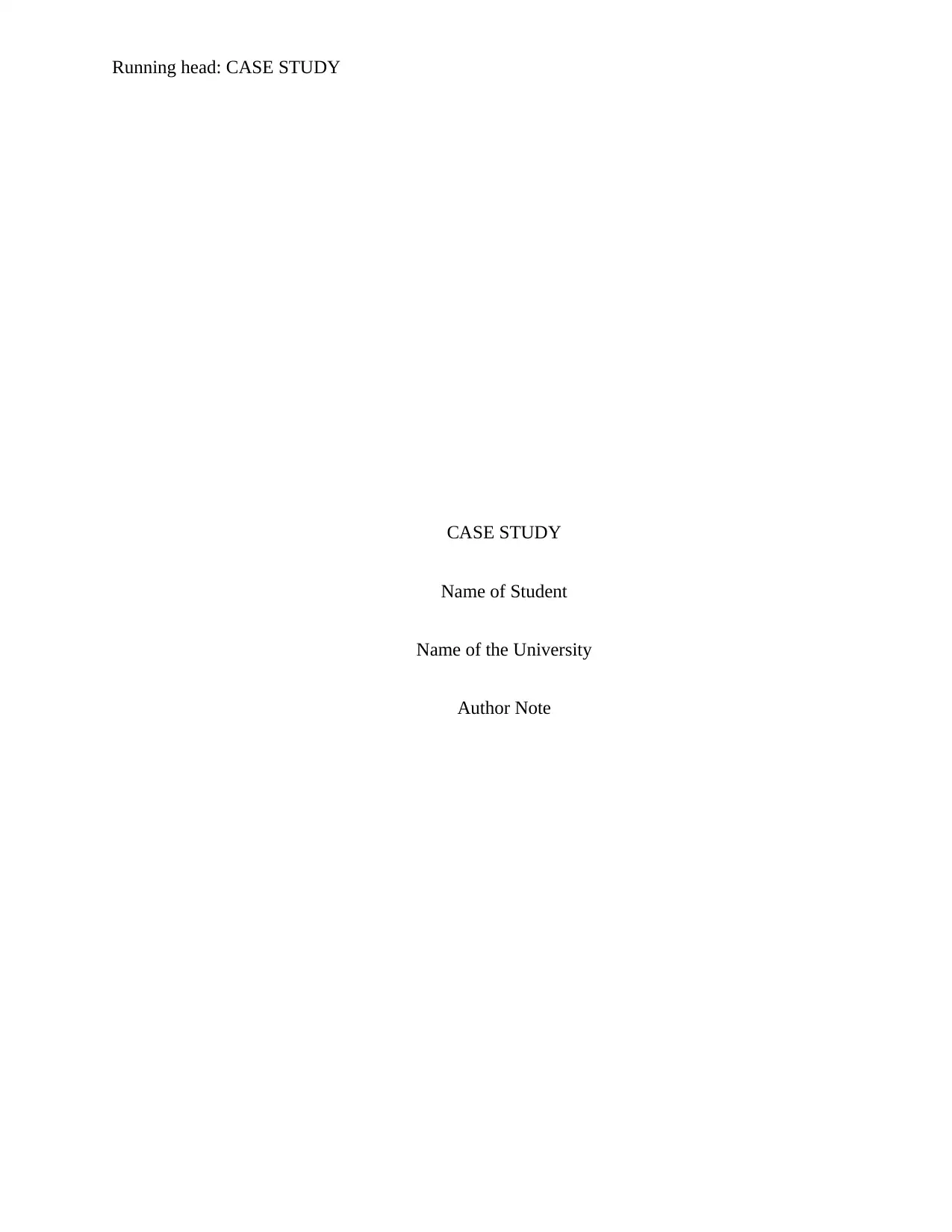
Running head: CASE STUDY
CASE STUDY
Name of Student
Name of the University
Author Note
CASE STUDY
Name of Student
Name of the University
Author Note
Paraphrase This Document
Need a fresh take? Get an instant paraphrase of this document with our AI Paraphraser
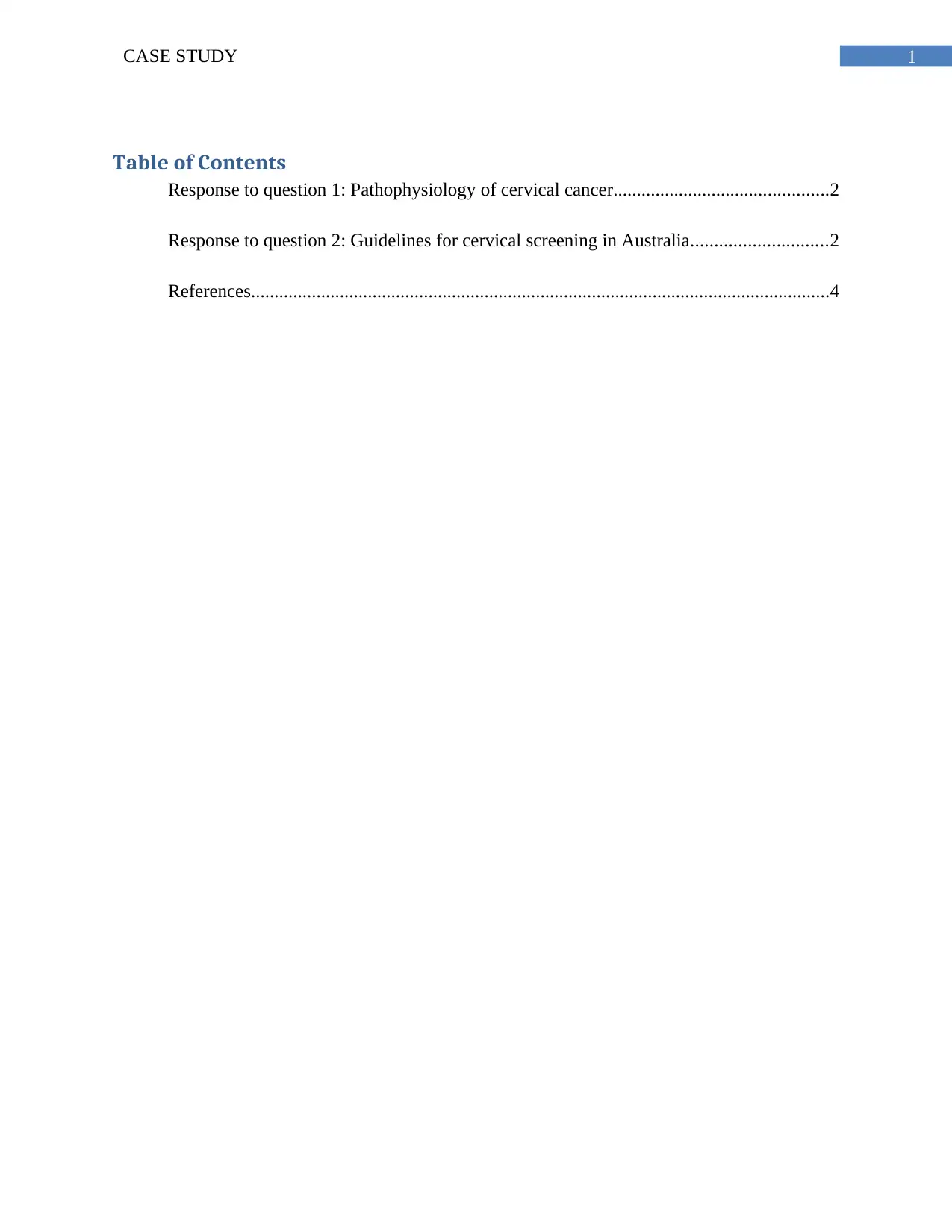
1CASE STUDY
Table of Contents
Response to question 1: Pathophysiology of cervical cancer..............................................2
Response to question 2: Guidelines for cervical screening in Australia.............................2
References............................................................................................................................4
Table of Contents
Response to question 1: Pathophysiology of cervical cancer..............................................2
Response to question 2: Guidelines for cervical screening in Australia.............................2
References............................................................................................................................4
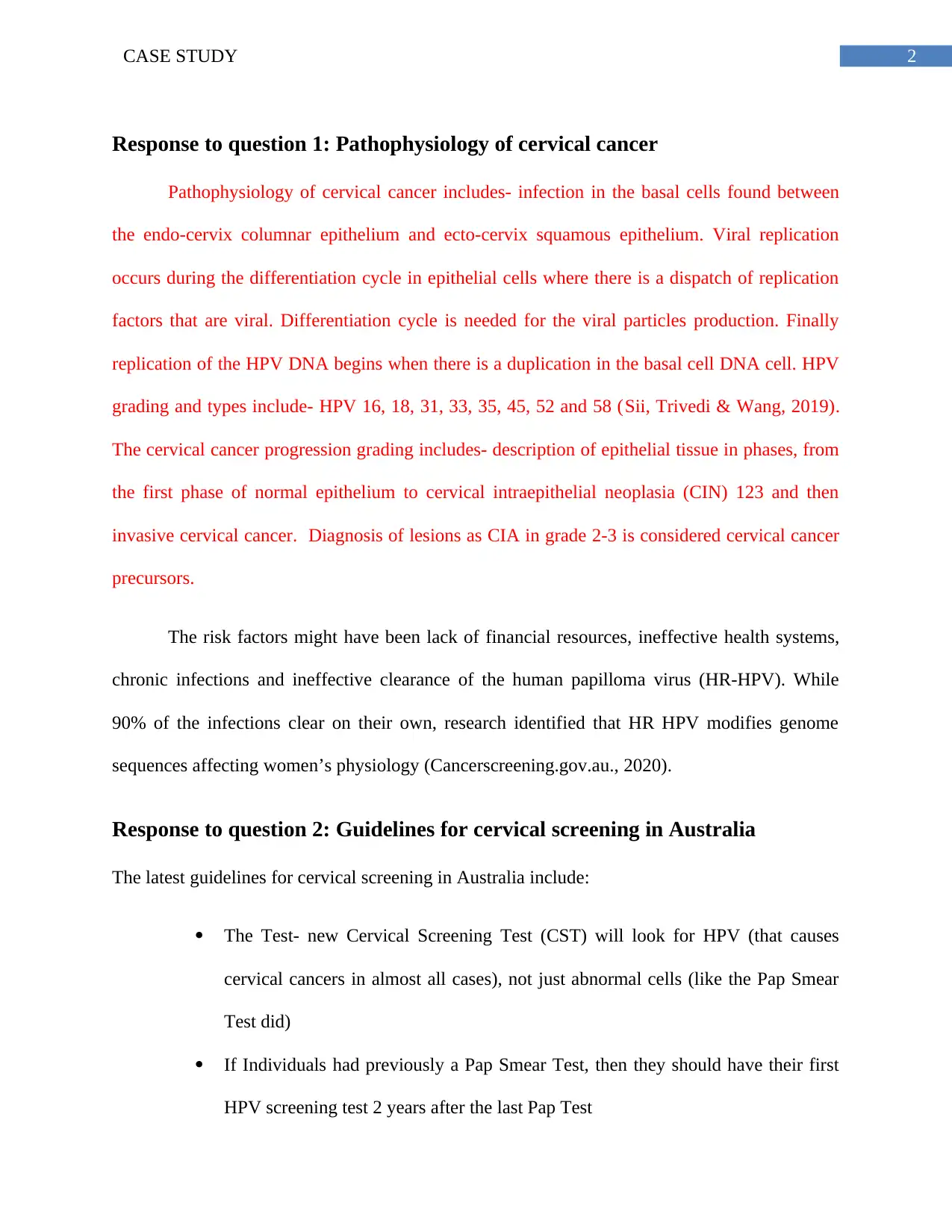
2CASE STUDY
Response to question 1: Pathophysiology of cervical cancer
Pathophysiology of cervical cancer includes- infection in the basal cells found between
the endo-cervix columnar epithelium and ecto-cervix squamous epithelium. Viral replication
occurs during the differentiation cycle in epithelial cells where there is a dispatch of replication
factors that are viral. Differentiation cycle is needed for the viral particles production. Finally
replication of the HPV DNA begins when there is a duplication in the basal cell DNA cell. HPV
grading and types include- HPV 16, 18, 31, 33, 35, 45, 52 and 58 (Sii, Trivedi & Wang, 2019).
The cervical cancer progression grading includes- description of epithelial tissue in phases, from
the first phase of normal epithelium to cervical intraepithelial neoplasia (CIN) 123 and then
invasive cervical cancer. Diagnosis of lesions as CIA in grade 2-3 is considered cervical cancer
precursors.
The risk factors might have been lack of financial resources, ineffective health systems,
chronic infections and ineffective clearance of the human papilloma virus (HR-HPV). While
90% of the infections clear on their own, research identified that HR HPV modifies genome
sequences affecting women’s physiology (Cancerscreening.gov.au., 2020).
Response to question 2: Guidelines for cervical screening in Australia
The latest guidelines for cervical screening in Australia include:
The Test- new Cervical Screening Test (CST) will look for HPV (that causes
cervical cancers in almost all cases), not just abnormal cells (like the Pap Smear
Test did)
If Individuals had previously a Pap Smear Test, then they should have their first
HPV screening test 2 years after the last Pap Test
Response to question 1: Pathophysiology of cervical cancer
Pathophysiology of cervical cancer includes- infection in the basal cells found between
the endo-cervix columnar epithelium and ecto-cervix squamous epithelium. Viral replication
occurs during the differentiation cycle in epithelial cells where there is a dispatch of replication
factors that are viral. Differentiation cycle is needed for the viral particles production. Finally
replication of the HPV DNA begins when there is a duplication in the basal cell DNA cell. HPV
grading and types include- HPV 16, 18, 31, 33, 35, 45, 52 and 58 (Sii, Trivedi & Wang, 2019).
The cervical cancer progression grading includes- description of epithelial tissue in phases, from
the first phase of normal epithelium to cervical intraepithelial neoplasia (CIN) 123 and then
invasive cervical cancer. Diagnosis of lesions as CIA in grade 2-3 is considered cervical cancer
precursors.
The risk factors might have been lack of financial resources, ineffective health systems,
chronic infections and ineffective clearance of the human papilloma virus (HR-HPV). While
90% of the infections clear on their own, research identified that HR HPV modifies genome
sequences affecting women’s physiology (Cancerscreening.gov.au., 2020).
Response to question 2: Guidelines for cervical screening in Australia
The latest guidelines for cervical screening in Australia include:
The Test- new Cervical Screening Test (CST) will look for HPV (that causes
cervical cancers in almost all cases), not just abnormal cells (like the Pap Smear
Test did)
If Individuals had previously a Pap Smear Test, then they should have their first
HPV screening test 2 years after the last Pap Test
⊘ This is a preview!⊘
Do you want full access?
Subscribe today to unlock all pages.

Trusted by 1+ million students worldwide
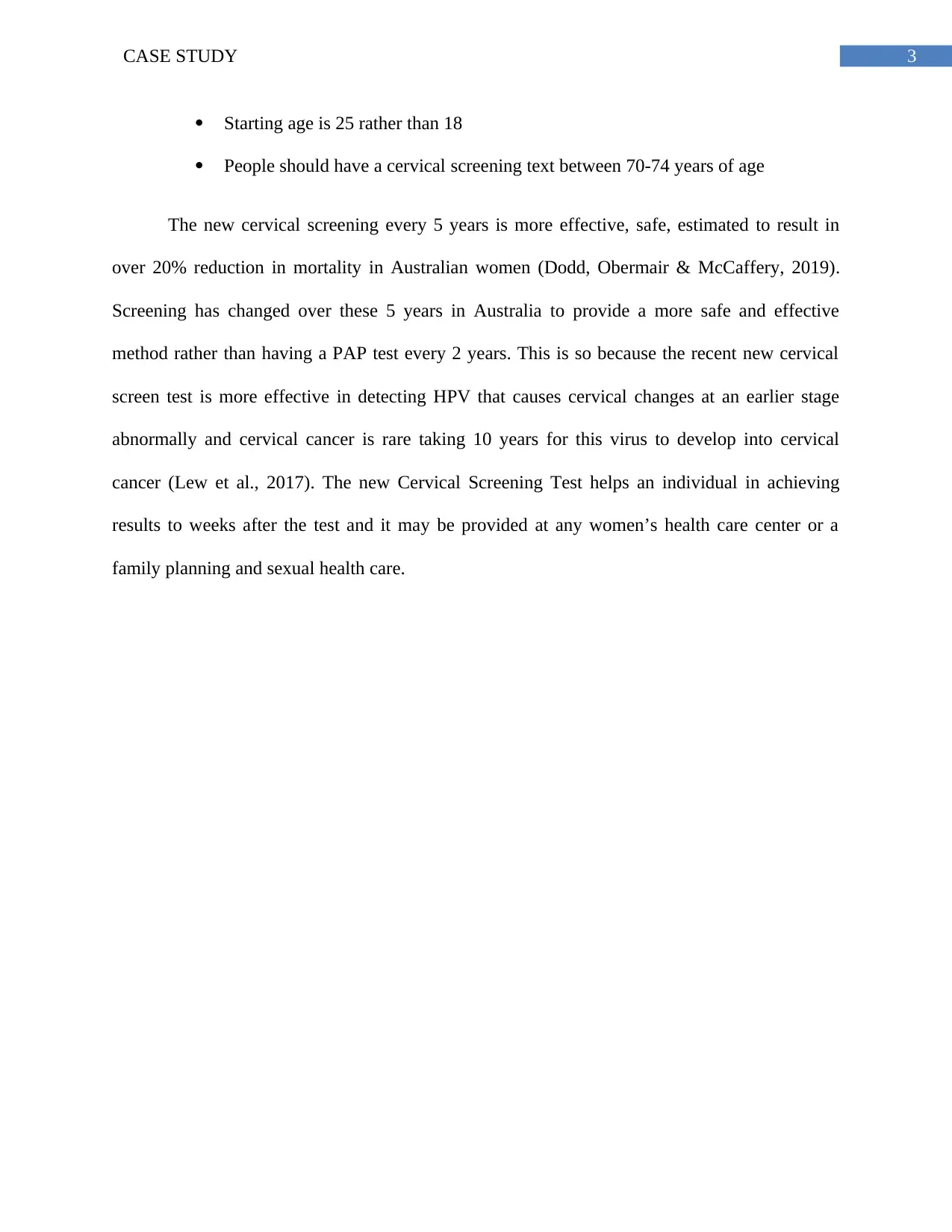
3CASE STUDY
Starting age is 25 rather than 18
People should have a cervical screening text between 70-74 years of age
The new cervical screening every 5 years is more effective, safe, estimated to result in
over 20% reduction in mortality in Australian women (Dodd, Obermair & McCaffery, 2019).
Screening has changed over these 5 years in Australia to provide a more safe and effective
method rather than having a PAP test every 2 years. This is so because the recent new cervical
screen test is more effective in detecting HPV that causes cervical changes at an earlier stage
abnormally and cervical cancer is rare taking 10 years for this virus to develop into cervical
cancer (Lew et al., 2017). The new Cervical Screening Test helps an individual in achieving
results to weeks after the test and it may be provided at any women’s health care center or a
family planning and sexual health care.
Starting age is 25 rather than 18
People should have a cervical screening text between 70-74 years of age
The new cervical screening every 5 years is more effective, safe, estimated to result in
over 20% reduction in mortality in Australian women (Dodd, Obermair & McCaffery, 2019).
Screening has changed over these 5 years in Australia to provide a more safe and effective
method rather than having a PAP test every 2 years. This is so because the recent new cervical
screen test is more effective in detecting HPV that causes cervical changes at an earlier stage
abnormally and cervical cancer is rare taking 10 years for this virus to develop into cervical
cancer (Lew et al., 2017). The new Cervical Screening Test helps an individual in achieving
results to weeks after the test and it may be provided at any women’s health care center or a
family planning and sexual health care.
Paraphrase This Document
Need a fresh take? Get an instant paraphrase of this document with our AI Paraphraser
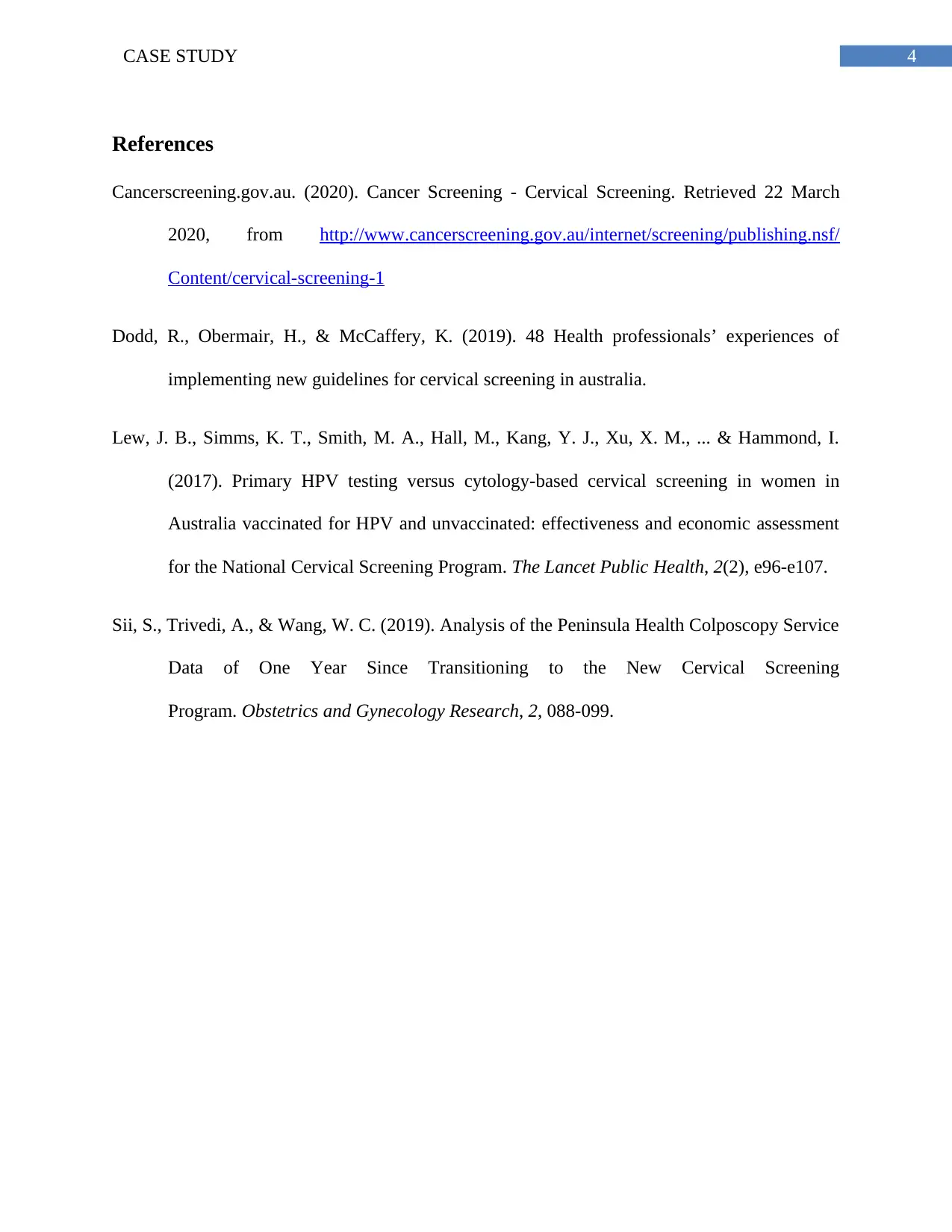
4CASE STUDY
References
Cancerscreening.gov.au. (2020). Cancer Screening - Cervical Screening. Retrieved 22 March
2020, from http://www.cancerscreening.gov.au/internet/screening/publishing.nsf/
Content/cervical-screening-1
Dodd, R., Obermair, H., & McCaffery, K. (2019). 48 Health professionals’ experiences of
implementing new guidelines for cervical screening in australia.
Lew, J. B., Simms, K. T., Smith, M. A., Hall, M., Kang, Y. J., Xu, X. M., ... & Hammond, I.
(2017). Primary HPV testing versus cytology-based cervical screening in women in
Australia vaccinated for HPV and unvaccinated: effectiveness and economic assessment
for the National Cervical Screening Program. The Lancet Public Health, 2(2), e96-e107.
Sii, S., Trivedi, A., & Wang, W. C. (2019). Analysis of the Peninsula Health Colposcopy Service
Data of One Year Since Transitioning to the New Cervical Screening
Program. Obstetrics and Gynecology Research, 2, 088-099.
References
Cancerscreening.gov.au. (2020). Cancer Screening - Cervical Screening. Retrieved 22 March
2020, from http://www.cancerscreening.gov.au/internet/screening/publishing.nsf/
Content/cervical-screening-1
Dodd, R., Obermair, H., & McCaffery, K. (2019). 48 Health professionals’ experiences of
implementing new guidelines for cervical screening in australia.
Lew, J. B., Simms, K. T., Smith, M. A., Hall, M., Kang, Y. J., Xu, X. M., ... & Hammond, I.
(2017). Primary HPV testing versus cytology-based cervical screening in women in
Australia vaccinated for HPV and unvaccinated: effectiveness and economic assessment
for the National Cervical Screening Program. The Lancet Public Health, 2(2), e96-e107.
Sii, S., Trivedi, A., & Wang, W. C. (2019). Analysis of the Peninsula Health Colposcopy Service
Data of One Year Since Transitioning to the New Cervical Screening
Program. Obstetrics and Gynecology Research, 2, 088-099.
1 out of 5
Related Documents
Your All-in-One AI-Powered Toolkit for Academic Success.
+13062052269
info@desklib.com
Available 24*7 on WhatsApp / Email
![[object Object]](/_next/static/media/star-bottom.7253800d.svg)
Unlock your academic potential
Copyright © 2020–2025 A2Z Services. All Rights Reserved. Developed and managed by ZUCOL.





